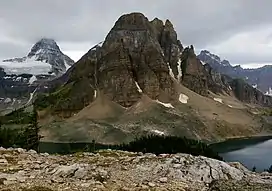Sunburst Peaks
Sunburst Peaks is a 2,849-metre (9,347-foot) mountain summit located in Mount Assiniboine Provincial Park, in the Canadian Rockies of British Columbia, Canada. Its nearest higher peak is Wedgwood Peak, 1.0 km (0.62 mi) to the south.[1] The mountain is situated immediately southeast of Sunburst Lake, west of Lake Magog, and south of Cerulean Lake.
| Sunburst Peaks | |
|---|---|
 Sunburst Peaks centered with Mt. Assiniboine behind left | |
| Highest point | |
| Elevation | 2,849 m (9,347 ft)[1] |
| Prominence | 79 m (259 ft)[1] |
| Parent peak | Wedgwood Peak (3024 m)[1] |
| Listing | Mountains of British Columbia |
| Coordinates | 50°54′12″N 115°39′28″W[2] |
| Geography | |
 Sunburst Peaks Location of Sunburst Peaks in British Columbia  Sunburst Peaks Sunburst Peaks (Canada) | |
| Country | Canada |
| Province | British Columbia |
| District | Kootenay Land District |
| Protected area | Mount Assiniboine Provincial Park |
| Parent range | Park Ranges ← Canadian Rockies |
| Topo map | NTS 82J13 Mount Assiniboine[2] |
| Geology | |
| Age of rock | Cambrian |
| Type of rock | sedimentary rock |
| Climbing | |
| First ascent | 1910 T.G. Longstaff, Katherine Longstaff, Rudolph Aemmer[1] |
| Easiest route | Scrambling[3] |
History

The first ascent of the peak was made in 1910 by Katherine Longstaff and her brother Dr. Tom Longstaff, with Rudolph Aemmer as their guide.[4]
The mountain was named Sunburst Peak in 1953 after Sunburst Lake, which had been named by the Interprovincial Boundary Survey.[4] The name was officially changed by the Geographical Names Board of Canada to Sunburst Peaks (plural) on February 15, 1983 with the intention extended to apply to three peaks.[5] [2]
Geology
Sunburst Peak is composed of sedimentary rock laid down during the Cambrian period. Formed in shallow seas, this sedimentary rock was pushed east and over the top of younger rock during the Laramide orogeny.[6]
Climate
Based on the Köppen climate classification, Sunburst Peak is located in a subarctic climate zone with cold, snowy winters, and mild summers.[7] Temperatures can drop below −20 °C with wind chill factors below −30 °C. Precipitation runoff from the peak drains into headwaters of the Mitchell River.
References
- "Sunburst Peak". Bivouac.com. Retrieved 2019-02-03.
- "Sunburst Peaks". Geographical Names Data Base. Natural Resources Canada. Retrieved 2019-02-04.
- "Sunburst Peak (Goat's Tower) | explor8ion". Archived from the original on 2019-02-07. Retrieved 2019-02-06.
- Sunburst Peak PeakFinder
- "Sunburst Peaks". BC Geographical Names. Retrieved 2021-06-15.
- Gadd, Ben (2008), Geology of the Rocky Mountains and Columbias
- Peel, M. C.; Finlayson, B. L.; McMahon, T. A. (2007). "Updated world map of the Köppen−Geiger climate classification" (PDF). Hydrol. Earth Syst. Sci. 11 (5): 1633–1644. Bibcode:2007HESS...11.1633P. doi:10.5194/hess-11-1633-2007. ISSN 1027-5606.
External links
- Weather forecast: Sunburst Peaks
- Mount Assiniboine Provincial Park
- Sunset at Sunburst Peaks YouTube